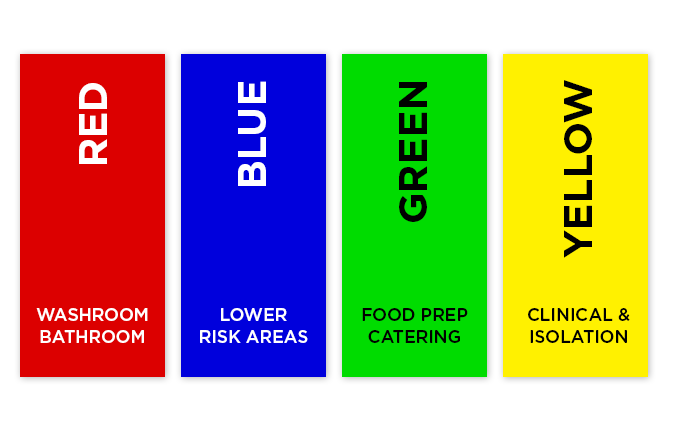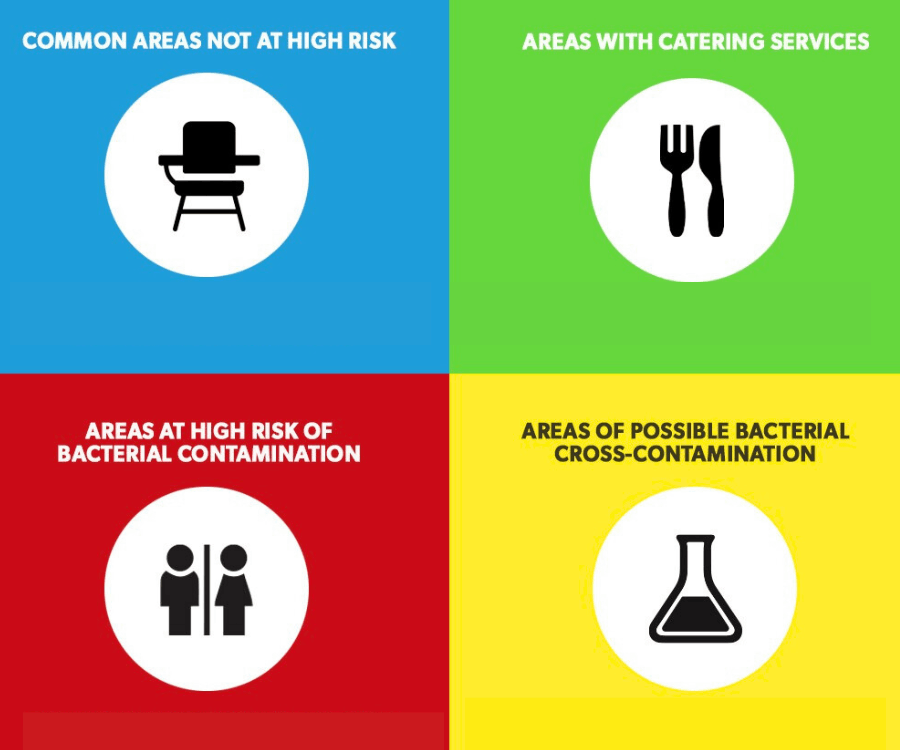
Do you know that more than 50% of surfaces in an office are contaminated with high levels of bacteria, making it crucial to maintain a clean and sanitized environment. Now imagine living in that space and not even knowing about it. But thanks to the color coding system, it is not like that anymore.
Basically, color coding plays an important role in optimizing a workplace while also avoiding cross-contamination. Put simply, it’s a cleaning system that involves assigning different colored tools and supplies to specific areas of the workplace. The right color-coded cleaning plan can increase efficiency, reduce contamination risks, and help you maintain safety standards.
With this blog post, we’ll explore the details of what is colour coding in cleaning as well as its benefits for both businesses and employees so that you have all the information you need to make informed decisions about your solutions.
What Is Colour Coding In Cleaning?

Color-coded cleaning is a system that assigns specific colors to cleaning equipment and products for different areas or tasks in a facility. This method is used to reduce the risk of cross-contamination and improve overall hygiene and sanitation.
Moreover, the system allows for easy identification and organization of cleaning materials, ensuring that they are used in the correct area and not mixed with others. This practical and efficient cleaning strategy is highly recognized by hospitals, hotels, and other public settings as an essential tool to maintain cleanliness and safety.
Colors For Color Coding In Cleaning
When it comes to cleaning, color coding is a crucial aspect to consider to reduce cross-contamination and create a clean and sanitary environment. The industry-standard color-coding system assigns specific colors to cleaning tools based on the area and the type of cleaning required.
In total, there are four colors commonly used for color coding in cleaning and each color corresponds to a specific area or task:
- Red: red is designated for high-risk areas such as toilets and bathrooms
- Yellow: yellow requires a cautious approach, so it is reserved for specialty applications like cleaning medical areas
- Green: green is dedicated to general food preparation and serving areas
- Blue: It is for general cleaning purposes, so it is reserved for low-risk areas such as offices and hallways.
By having a clear color-coded system and effective training, cleaning staff can ensure that they are using the appropriate tools and chemicals in the right areas, thus promoting a safe and hygienic environment.
Benefits of Color-Coding

In any organization, the cleanliness of the premises is of utmost importance, not only for hygiene reasons but also for the safety of employees and visitors. To ensure that an environment is kept clean, it is essential to have a systematic cleaning process to follow.
One process that has gained popularity over the years is the use of a color-coded cleaning system. Implementing this method provides various benefits that can help organizations in maintaining a clean, safe, and healthy environment. Take a look at a few benefits:
1. Minimize The Risk Of Infection
To keep facilities free from viral and bacterial infections, it is essential to minimize the risk of contamination during cleaning processes. Using a color-coded cleaning system helps to reduce the use of contaminated cleaning tools in different areas.
When the colors are assigned to different areas or surfaces, it helps workers remember to use specific tools for particular areas to avoid bringing in unwanted germs.
2. Reduces The Chance Of Cross-Contamination
The use of color-coded cleaning equipment such as cloths, mops, and buckets, allows for dedicated tools to be used for each location in the facility in an organized manner.
The system helps to prevent the spread of harmful microorganisms from one area to another, such as the transfer of bacteria from a restroom to a kitchen.
3. Saves Time And Minimizes Mistakes
Implementing a color-coded system saves time as workers can quickly identify the correct cleaning equipment needed for a particular job.
This results in workers being able to work more efficiently, minimizing wasted time due to misplaced or mismatched tools. The system can also help reduce costly work or equipment errors.
4. Improved Employee Health, Safety, And Productivity
Using a color-coded system helps to minimize the risk of employee injuries. The system helps workers select the right tools for tasks, eliminating the need to climb ladders or use tools not intended for their designated function.
This results in safer working conditions and reduced risk of work-related accidents. As a result, it also improves worker productivity as they can focus on their tasks with minimal disruptions.
5. Makes Training Easier
Training workers on the best practices for cleaning can be challenging, but using a color-coded system makes it easier. The system simplifies tasks by matching the appropriate color-coded kit to the corresponding area or surface that needs cleaning.
The consistency of the process also helps workers gradually build the habit of following the set process.
6. Inexpensive
Implementing a color-coded cleaning system is relatively inexpensive. The system’s simplicity means it can be implemented with ease across a facility or an entire organization.
As a result, organizations can significantly improve their cleaning process without breaking the bank.
Conclusion
Taking all the above into consideration, it’s clear to see that implementing a color-coded cleaning system at your business is beneficial. Not only does it serve as a safety precaution and provide an economical solution to preventing cross-contamination in food production areas, but it can save time, protect workers from allergies and asthma, and ensure the overall cleanliness of the workplace.
By carefully planning out different colors not just for each specific area or task but also for each cleaning product or tool used, you can achieve maximum efficiency in keeping your environment safe from anything that may harm its inhabitants. Color coding is certainly worth considering as a vital part of any successful workplace, as doing so will guarantee a great return on investment in terms of safety and productivity.

